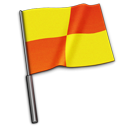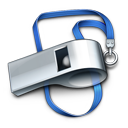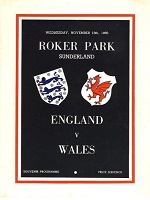|
|
flg.jpg)  "ENGLAND
FORWARDS WERE SUPERB"
Daily Herald "ENGLAND
FORWARDS WERE SUPERB"
Daily Herald |
  Officials Officials |
England |
UK ruling on substitutes |
Wales |
Referee
John Alexander Mowat
43/44 (1906), Rutherglen |
"The gates will be
opened at 12.45 and for the first time in England, the Football
Association's new flag, designed by the Heraldry Office, will be flown at
Roker Park" - The Sunderland
Echo, Tuesday, 14 November 1950 |
|
Linesmen |
Ian C.
Inglis
Edinburgh |
William H.
Quinn
Dumfries |
|
|
|
flg.jpg) England
Team England
Team |
| |
|
Rank |
No official ranking system established;
ELO rating 4th |
Colours |
The 1949 home
uniform -
White collared jerseys, blue shorts, black socks with white
tops.
|
|
P 15th of 43, W 11 - D 0 - L 4 - F
44 - A 21. |
Captain |
Alf Ramsey |
Manager |
Walter Winterbottom, 37 (31 March 1913), appointed as FA national director of coaching/team manager on 8 July 1946; |
|
first of three, W 1 - D 0 - L 0 - F 4 - A 2. |
Trainer: George Gray (Sunderland AFC) |
P 34th of 139, W 25 - D 3 - L 6 - F 110 - A 36. |
|
|
Team chosen by Selection Committee headed by Arthur Drewry, on Tuesday, 7
November, in London. |
flg.jpg) England
Lineup England
Lineup |
|
|
six changes
to the previous match (Aston,
Wright, Chilton, Matthews, Lee & Langton out) |
league position
(7 November) |
|
|
|
Williams, Bert F. |
30
288 days |
31 January 1920 |
G |
Wolverhampton Wanderers FC
(FL 6th) |
12 |
13ᵍᵃ |
|
2 |
Ramsey, Alfred E. |
30
297 days |
22 January 1920 |
RB |
Tottenham Hotspur FC
(FL 4th) |
10 |
0 |
|
699 |
3 |
Smith, Lionel |
30
84 days |
23 August 1920 |
LB |
Arsenal FC
(FL TOP) |
1 |
0 |
|
the 21st/22nd Arsenal player to represent
England |
|
4 |
Watson,
Willie |
30
253 days |
7 March 1920 |
RHB |
Sunderland AFC
(FL 16th) |
3 |
0 |
|
700 |
5 |
Compton, Leslie H. |
38
64 days |
12 September 1912 |
CHB |
Arsenal FC
(FL TOP) |
1 |
0 |
|
oldest outfield debutant |
the 21st/22nd Arsenal player to represent
England |
|
6 |
Dickinson, James W. |
25
205 days |
24 April 1925 |
LHB |
Portsmouth
FC (FL 14th) |
12 |
0 |
|
7 |
Finney,
Thomas |
28
224 days |
5 April 1922 |
OR |
Preston
North End FC (FL2
10th) |
29 |
18 |
8
 |
Mannion,
Wilfred J. |
32
183 days |
16 May 1918 |
IR |
Middlesbrough FC
(FL 3rd) |
23 |
11 |
9
 |
Milburn, John E.T. |
26
188 days |
11 May 1924 |
CF |
Newcastle United FC
(FL 2nd) |
9 |
7 |
10
  |
Baily, Edward F. |
25
101 days |
6 August 1925 |
IL |
Tottenham Hotspur FC
(FL 4th) |
3 |
4 |
|
the
154th (21st post-war) brace scored |
|
701 |
11 |
Medley, Leslie D. |
30
73 days |
3 September 1920 |
OL |
Tottenham Hotspur FC
(FL 4th) |
1 |
0 |
|
the 19th Hotspur player to represent
England |
|
reserves: |
Willie Watson and
Nat Lofthouse (Bolton Wanderers FC
(FL 11th)). Watson was not replaced.
"The English selectors will not call upon another reserve. Should the
unexpected occur there are enough top-class players in the Sunderland,
Newcastle and Middlesbrough areas to call upon at the last moment." -
The Press and Journal, Tuesday, 14 November 1950. |
|
team changes: |
Billy Wright
(Wolverhampton Wanderers FC (FL
6th)), original captain and right-half,
was in line to win his record 34th consecutive appearance, until he
received a strained back in his team's match against Burnley. Despite
treatment, he was withdrawn on Monday, 13th. Watson took his place the
day before the match. |
|
team notes: |
Following the debuts of Smith, Compton and
Medley, the International Selection Committee, in the Winterbottom
era, have now used fifty different players. |
|
records: |
This is England's sixth victory in 1950, a
record-equalling achievement. |
|
England team were set up at the
Seaburn Hotel in Whitley Bay and trained on the North Shields ground,
prior to this match. |
|
|
|
2-3-5 |
Williams
-
Ramsey, Smith -
Watson, Compton, Dickinson -
Finney,
Mannion, Milburn, Baily, Medley |
|
Averages: |
Age |
29 years 346
days |
Appearances/Goals |
9.5 |
3.3 |
|
|
|
 Wales
Team Wales
Team |
| |
|
Rank |
No official ranking system established;
ELO rating 25th |
Colours |
Made by Umbro -
Red jerseys with white collars,
white shorts, red socks with white tops. |
|
Captain |
Wally Barnes |
Selection |
Selection Committee
on Monday, 30
October 1950 |
|
led by the secretary, Herbert Powell |
 Wales
Lineup Wales
Lineup |
|
|
Hughes, Iowerth |
25
173 days |
26 May 1925 |
G |
Luton Town FC |
1 |
4ᵍᵃ |
|
2 |
Barnes, Wallace |
30
303 days |
16 January 1920 |
RB |
Arsenal FC, England |
12 |
0 |
|
3 |
Sherwood, Alfred T. |
27
2 days |
13 November 1923 |
LB |
Cardiff City FC |
15 |
0 |
|
4 |
Paul, Roy |
30
211 days |
18 April 1920 |
RHB |
Manchester City FC, England |
11 |
1 |
|
5 |
Daniel, W.
Raymond |
22
13 days |
2 November 1928 |
CHB |
Arsenal FC, England |
1 |
0 |
|
6 |
Lucas, William H. |
32
304 days |
15 January 1918 |
LHB |
Swansea Town FC |
7 |
0 |
|
final app
1948-50 |
7
  |
Griffiths, W.
Malwyn |
31
252 days |
8 March 1919 |
OR |
Leicester City FC, England |
7 |
1 |
|
8 |
Allen, Brynley W. |
29
237 days |
23 March 1921 |
IR |
Coventry City FC, England |
2 |
0 |
|
final app
1950 |
9
  |
Ford, Trevor |
27
45 days |
1 October 1923 |
CF |
Sunderland AFC, England |
16 |
12 |
|
=mst gls |
|
10 |
Allchurch, Ivor J. |
20
334 days |
16 December 1929 |
IL |
Swansea Town FC |
1 |
0 |
|
11 |
Clarke, Royston J. |
25
167 days |
1 June 1925 |
OL |
Manchester City FC, England |
6 |
1 |
|
reserves: |
Ron
Stitfall (Cardiff City). Billy Lucas (Swansea Town FC) was asked to be
a travelling reserve a couple of days prior. |
|
team changes: |
On the day of the match, Ron Burgess
(Tottenham Hotspur FC) had to withdraw because of injury (swollen
right calf muscle), his place going to Lucas, who had been called up
as a travelling reserve the day before. |
|
team notes: |
Ray Daniels, the Arsenal FC
reserve centre-half, had only played in seven league matches over the
past three seasons.
Trevor Ford becomes the first Sunderland player
to play for Wales since 1910, thirteen days after signing for the
Wearside club. |
|
Prior to this match, the Welsh team were training on Newcastle
United's St. James' Park. |
|
|
|
2-3-5 |
Hughes
-
Barnes, Sherwood -
Paul, Daniel, Lucas -
Griifiths, Allen,
Ford, Allchurch, Clarke. |
|
Averages: |
Age |
27 years 220
days |
Appearances/Goals |
7.2 |
1.0 |
|
|
|
|
Match Report by
Mike Payne |
|
 This
was undoubtedly the best Welsh performance against England since the war
and the fact that England, at times, had to be at their most brilliant
best says it all. On a treacherous surface and on a bitterly cold day, the
football served up warmed the crowd to fever pitch as the excitement grew. This
was undoubtedly the best Welsh performance against England since the war
and the fact that England, at times, had to be at their most brilliant
best says it all. On a treacherous surface and on a bitterly cold day, the
football served up warmed the crowd to fever pitch as the excitement grew.
Excellent precision
passing by Wilf Mannion, Eddie Baily, Jackie Milburn, Les Medley and Tom
Finney had given England a bright opening. However, the Welsh terriers
were continually snapping at their heels with Daniel, Paul and Lucas
working tirelessly in the midfield battle. Gradually though the extra
class began to show and three of the four England goals were pure genius.
Wales
had the ball in the net on the half-hour but Clarke's shot was ruled out
for offside. A few seconds later, England took the lead as a long
controlled clearance by Lionel Smith, who had a good game, reached Baily
on the edge of the penalty area. The Spurs player flicked the ball up with
his right foot and crashed it into the net with his left for a wonderful
goal.
The England attack, well prompted by Willie Watson and Jimmy
Dickinson, then began to flow superbly. The ball was moving forward
quickly and smoothly.
Five minutes before half-time England scored
their second. Again it was a shot by Baily that did the trick when he
finished off a splendid round of passing by Finney, Mannion, Watson and
Mannion again. It seemed that the 2-0 interval lead had put England clear
but with Allchurch and Ford showing some tremendous play it was far from
over.
Indeed, with only three minutes of the second half gone Wales
pulled a goal back. Griffiths put over a fine centre which landed between
Leslie Compton and Bert Williams, and before either could react, Ford
nipped in smartly to flick the ball in with his head.
It was end to
end stuff now as both sides searched for another goal. Ford forced two
brilliant saves out of Williams and then Baily saw his 20-yard shot strike
the Welsh crossbar. A scramble on the England goal-line almost produced an
equaliser before, on 66 minutes, the home side engineered the next crucial
goal. Again it was a super strike. Mannion was the man on target this
time, cleverly flicking the ball past Hughes after Watson and Milburn had
created the opening.
Still Wales refused to lie down and five
minutes later it was 3-2. Once more the combination of Griffiths and Ford
gave the centre-forward the chance to touch the ball past Williams with
the other England defenders off balance. So the excitement continued until
the dying seconds, after another flowing move between Finney, Mannion,
Baily and Milburn, the England number-nine shot home from an acute angle.
That put the final stamp on England's extra quality and authority and was
the last action of a magnificent afternoon's football.
|
|
Match Report by
Norman Giller |
|
Injured Billy Wright missed
his first after
33 successive matches. Alf Ramsey took over as skipper. Eddie Baily, nicknamed
the 'Cheeky Chappie' because of his impersonation of comedian Max Miller,
repeated his two-goal act. Arsenal centre-half Leslie Compton made his England
debut at the age of thirty-eight alongside County cricketing colleague Willie
Watson. Leslie remains the oldest player ever to have made an England debut.
Les Medley partnered his Tottenham team-mate Baily on the left wing. Lionel
Smith, converted from centre-half by Arsenal, came in at left-back. Goalkeeper
Bert Williams kept his place in goal to maintain the Wolves record of having
at least one player in the England team in every international match since the
war. Trevor Ford, playing for Wales in front of his Sunderland fans, scored
twice in the second half to give the Welsh the hope of a championship point.
It was not until Jackie Milburn scored in the final seconds that England could
feel confident that they had the match won.
|
|
Match Report
as appears in the F.A. Yearbook 1951-52, page 23 |
|
For England's next match, against Wales at Roker Park, Sunderland, there
were several changes from the team that beat Ireland; Finney,
Milburn, and Medley replacing Matthews, Lee and Langton in the forward
line, and Smith, Watson and Compton (L) replacing Aston, Wright and
Chilton in defence.
This was one of the best International matches seen
since the war, with both sides playing superb football. England's first
goal came in the 30th minute, after a claim for a Welsh goal had been
disallowed: it was Baily who scored with a classic left-foot shot after a
pass from Smith. Five minutes before the interval, Baily scored again
after Finney, Mannion and Watson had taken part in a complicated round of
passing.
Though Wales were two-down at half-time, they kept up the
fight to the end, Ford, their centre-forward particularly distinguishing
himself. Three minutes after the interval, Griffiths pitched a perfect
centre between Compton and Williams, and Ford flicked the ball into the
net. Wales then went into the attack and there were some awkward moments
for England. But after 21 minutes England went further ahead with a fine
goal by Mannion after Watson and Milburn had made an opening. Wales still
refused to accept defeat, and five minutes later the score was 2-3, Ford
again scoring with a fast low shot from a pass by Griffiths. In the last
seconds, Milburn was successful with an acute angle shot after a clever
movement by Finney, Mannion and Baily, and set the seal on England's
victory.
|
In
Other News....
|
It was on 15 November 1950 that the inquiry into the
Knockshinnoch Castle Colliery disaster in Ayrshire, two
months earlier, continued to deliberate on the causes,
whereby 13 men had died when a huge underground lake of peat
and moss sank into the mine, creating a surface crater that
covered two acres to a depth of up to 45 feet, above it. 116
men escaped, but were trapped underground for over two days
before being rescued. Less than two years later, a
dramatised film of the disaster, called 'The Brave Don't
Cry', was released. |
|
|
|
|
Source
Notes |
TheFA.com
Original newspaper reports
Wales' Complete Who's Who since 1946
Drew Herbertson, Scottish FA historian |
|
Rothman's Yearbooks
Mike Payne's England: The Complete Post-War Record
Norman Giller, Football Author
British Pathé |
|
|
cg |

